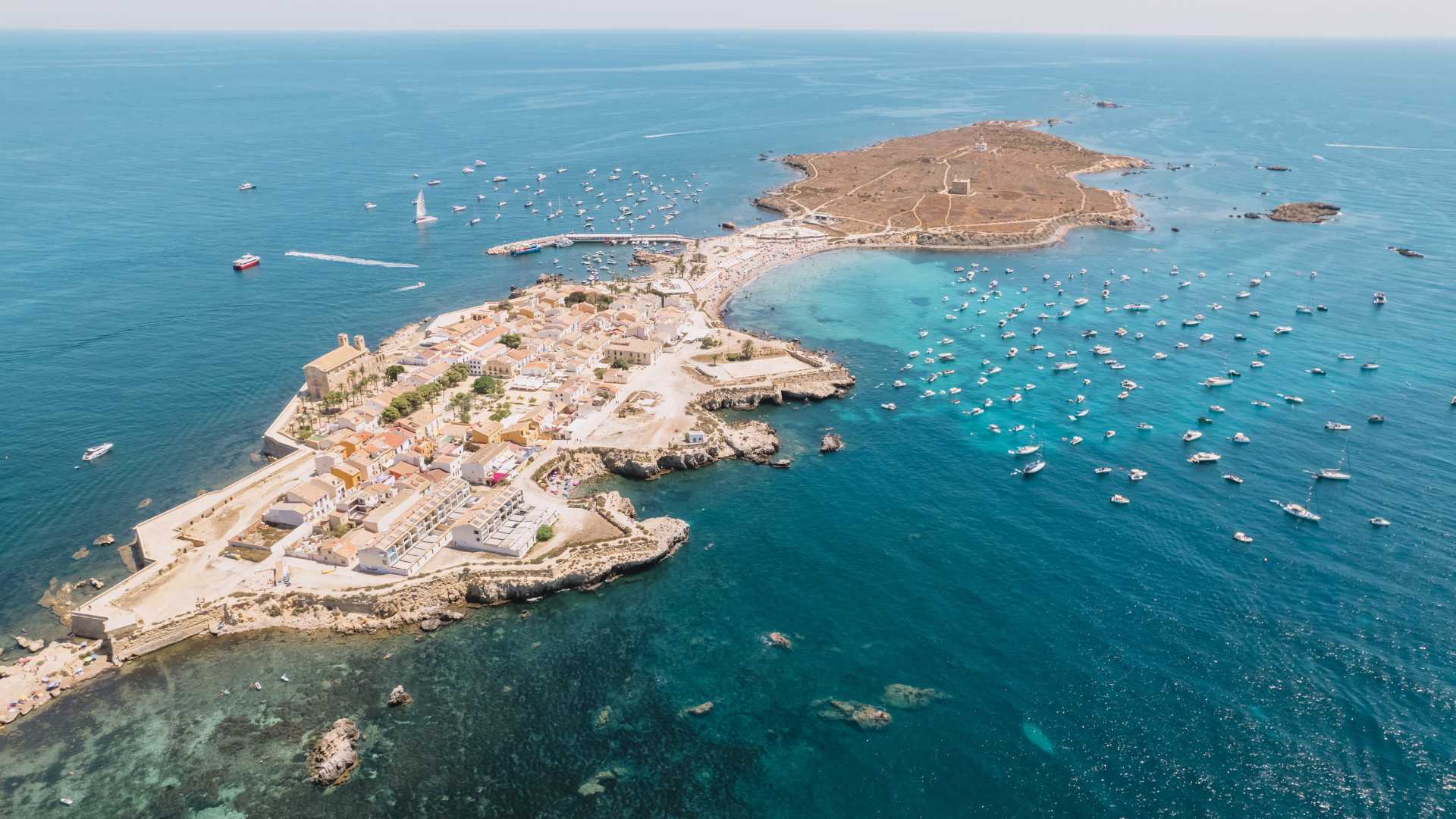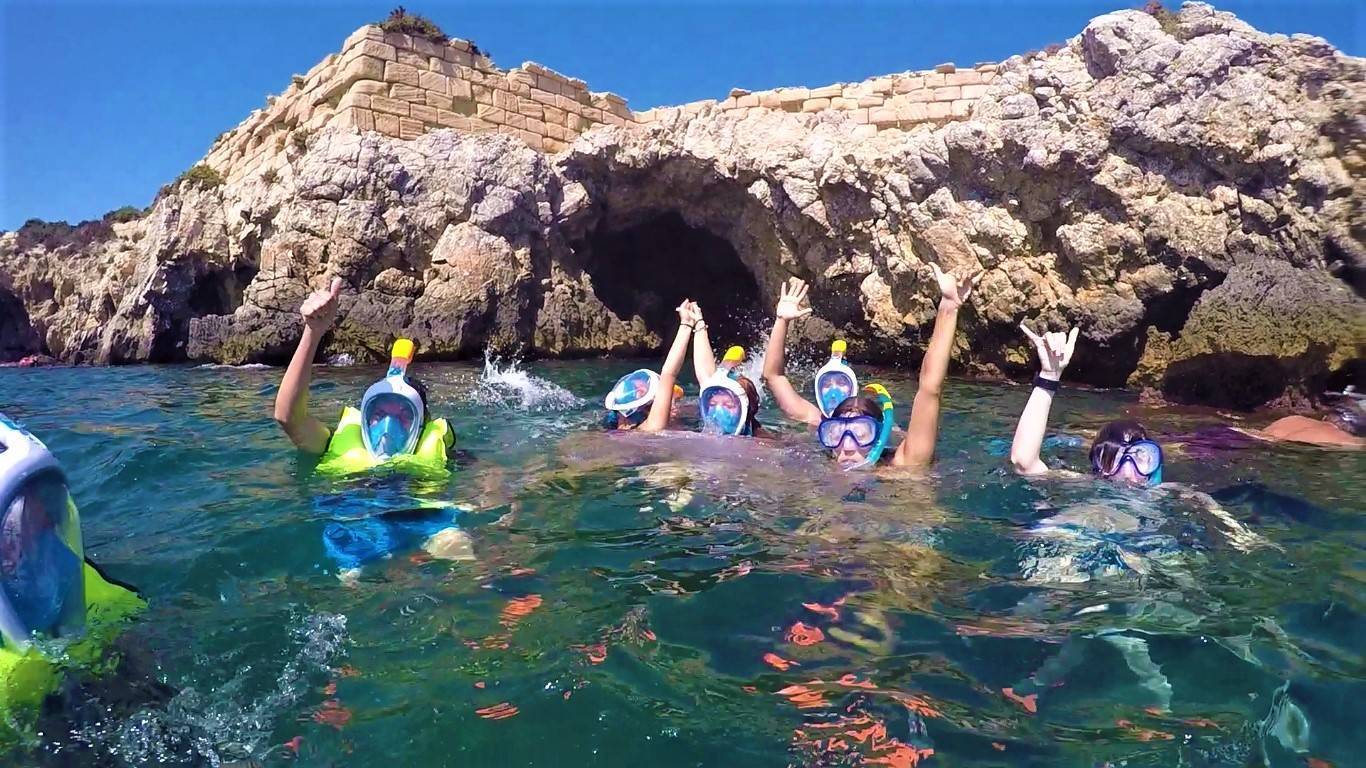Tabarca Island: What to See, How to Get There, Beaches, and Gastronomy
A trip to New Tabarca Island is one of the most classic and charming plans to enjoy an unforgettable day on the Costa Blanca (Alicante).
How to Get to Tabarca
The boat route from Santa Pola, the nearest port, takes about 25 minutes. Although there are ferry connections from other places like Alicante, Torrevieja, and Benidorm, Santa Pola is the fastest and most economical option. The trip from Alicante takes around 1 hour.
Explore the Island
Once you arrive at Tabarca, we recommend taking a walk through the fortified town, which holds a rich cultural heritage. Don’t miss a swim at the central sandy beach or one of the many beautiful coves with crystal-clear water. Additionally, it’s ideal to go snorkeling in the marine reserve and, of course, enjoy the exquisite local fish restaurant.
If you have time and energy, we suggest hiking to the uninhabited part of the island, where you’ll find iconic spots like the Lighthouse, San José Tower, the Cemetery, and the famous Captain’s Cross. With a total length of only 2 kilometers, the walk is very accessible.

Main Attractions on Tabarca Island
Tabarca is a small island measuring 2 kilometers in length and 400 meters in width, located 6 kilometers from Santa Pola and 20 km from Alicante. It is the only inhabited island in the Valencian Community, with a population that decreases during the winter months.
What to See on Tabarca Island?
Here’s an overview of the key attractions you shouldn’t miss:
- Museo Nueva Tabarca: Located upon arrival, free admission.
- The District: Old walls and gates, the church, Casa del Francés (located on the cliffs), and charming streets and squares.
- Beaches and Coves: Central sandy beach and many coves ideal for swimming and snorkeling.
- Uninhabited Part: Historical monuments and natural reefs.
- Fish Restaurant: Delicious local dishes reflecting the island’s fishing tradition.
- Guided Tour: Experience the island’s history and pirate legends on a free tour, pay what you think is fair.
Continue reading for more details!
Recommendations for Your Visit
- Transportation: Choose the boat from Santa Pola for a quick and economical arrival. If you prefer a longer experience, consider a catamaran excursion from Alicante, lasting 6 hours.
- Equipment: Don’t forget to bring sunscreen, swimwear, a towel, water shoes, and comfortable shoes to explore the uninhabited part.
- Snorkeling: If you enjoy snorkeling, bring your own gear to make the most of Tabarca’s crystal-clear waters.
- Light Baggage: Take only what you need to move freely. A backpack is ideal for this purpose.
- Pre-booking: Purchase your tickets online in advance. Tabarkeras, a company with a tradition since 1975, is an excellent option to reserve your excursion.
- Best Time to Visit:
- June, September, and October: Ideal for those who love the sea and diving, with fewer people.
- July and August: Peak season with more noise.
- Spring and Off-season: The island is quieter, with lush vegetation in the spring.
If you plan to spend more days on the Costa Blanca, don’t miss our guides on Benidorm, Altea, Torrevieja and other nearby destinations.
Accommodation on Tabarca
Spending a night on Tabarca allows you to enjoy the magical sunsets and sunrises in a tranquil environment. Here are some accommodation options:
- Hotel Boutique Isla Tabarca: Located in the old Governor’s House.
- La Trancada: Charming country house, an old 18th-century fisherman’s house.
- Hostal Masin: Very close to the central beach.
Beaches and Coves on Tabarca
The Tabarca Marine Reserve surrounds the island and offers many coves and rocky areas, perfect for relaxing, sunbathing, swimming, diving, or enjoying a stunning sunset.
Main Beaches and Coves
- Central Beach: Locally known as Platja de l’Illa, the most visited due to its proximity to the urban core. It has restaurants, shops with sunbeds and umbrellas. In summer, it can be crowded, so we recommend exploring the nearby coves for a more peaceful atmosphere.
- Playa Grande (Platja Gran): Located southeast of the island, between the lighthouse and the cemetery. Highlighted by the presence of green stone cliffs and volcanic formations.
- Cala dels Birros: Located south of the town, ideal for snorkeling and admiring marine biodiversity, including posidonia, octopuses, starfish, and a variety of colorful fish.
- Cala del Francés or de la Guardia: Also south, near the central square. Houses Cova del Llop Marí, a cave where the once-extinct southern eagle lived.
Must-See Monuments
- San Pedro y San Pablo Church: Baroque style, declared as cultural interest (BIC) in 1964. Offers spectacular sea views, and its underground level hides important historical secrets.
- The Fortress: Built in 1769 by King Carlos III to defend the island against pirate attacks. Declared a historical and artistic collection in 1964, preserved with three entrance gates:
- Puerta de San Rafael (East Gate): Best preserved, with an inscription celebrating the friendship with San Pietro (Sardinia).
- Puerta de San Miguel (Alicante Gate): Located to the north, provides access to the old mill and offers a view of a small cove with crystal-clear water.
- Puerta de San Gabriel (La Cantera Gate): Offers a view of La Cantera Island, from which the stone for the construction of New Tabarca was extracted.
- San José Tower: Built in 1790, has served as a fortress, prison, and barracks. Now houses a storage facility for the Institute of Litoral Ecology.
- Tabarca Lighthouse: An example of 19th-century romantic engineering, now functions as a biological laboratory for the marine reserve.
Gastronomy on Tabarca
Tabarca’s cuisine reflects its fishing tradition with a focus on dishes from the Mediterranean cuisine:
- Caldero Tabarquino: A fish stew dish that is both creamy and broth-like, prepared with species such as dentón, mero, and gallo. Its intense flavor comes from the caldero broth, inherited from sailors who used small fish and surplus catches.
- Fideuá: Similar to paella but with thick noodles instead of rice, accompanied by fish, cuttlefish, and shellfish.
- Arroz a Banda: Two preparations in one: rice cooked in a broth with ñoras and aioli, and a separate dish with aioli, potato, and shredded fish.
Where to Eat
- Restaurante La Muralla: A quiet place away from the noise, with a terrace offering fantastic views and very friendly staff. Note that the menus range between €25 – €40.
Slow Travel Tourism on Tabarca
Although Tabarca is sometimes marketed as a mass tourism destination, it is much more than sun and beach. If you decide to spend a night on the island, you can enjoy a unique peace away from the daily hustle. Lovers of “slow travel” will appreciate the rich marine life, culinary delights, and coves waiting to be discovered, and the island deserves a longer stay to explore this corner with its special Mediterranean light.

Tabarca Marine Reserve: Spain’s First
Tabarca is part of an archipelago consisting of Tabarca Island, Islote de La Galera, Islote de La Cantera, and Islote de La Nao. Since 1986, it has been Spain’s first Marine Nature Reserve and has served as a model for other national and international protected marine area projects. Additionally, it has been declared a ZEPA (Zone of Special Protection for Birds) due to the large number of bird species that visit the island.
Underwater Richness
Tabarca’s seabeds are covered with Posidonia oceánica grass areas, exclusive to the Mediterranean and essential for marine biodiversity. These grass areas cleanse the water and provide shelter for larvae and fish. The reserve hosts a diversity of invertebrates and fish, and it is also a frequent habitat for sea turtles.
Diving Paradise
With crystal-clear water and rich fauna and flora, Tabarca is ideal for snorkeling and diving. Marine species include lobsters, dorado, mero, snails, starfish, and sponges, among others.
Hiking
A trail surrounds the island, providing opportunities to enjoy the coastal landscape and observe seabirds. The route starts at the San Pedro y San Pablo Church and offers views over Cabo de Santa Pola.
The History of Tabarca
The history of Tabarca dates back to the 18th century when King Carlos III relocated 69 Genoese families who were captured during the conquest of the Tunisian island Tabarka. Together with a military garrison, New Tabarca was established in 1768 to defend against pirate attacks. In the 19th century, the population reached 1,000 inhabitants, primarily dedicated to fishing. Today, around 50 people live permanently on the island, while the population increases significantly in the summer.
